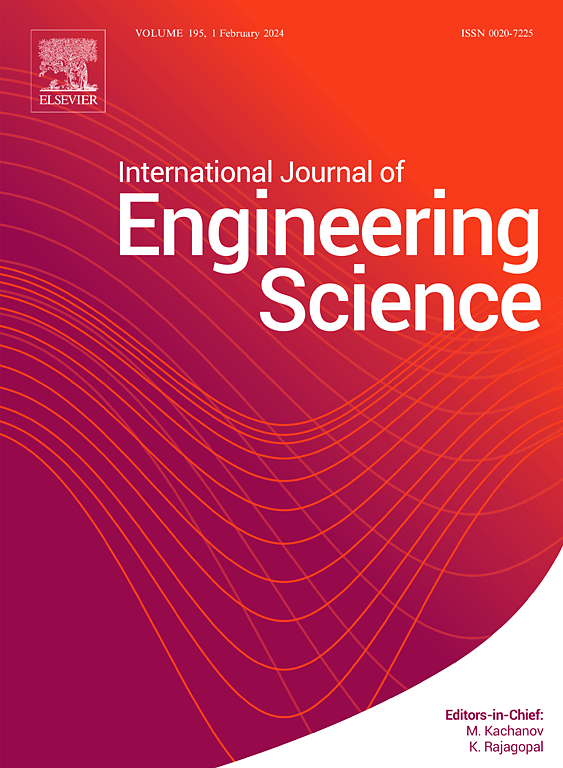静电驱动双微梁结构的全局极限点行为和多稳定阈值
IF 5.7
1区 工程技术
Q1 ENGINEERING, MULTIDISCIPLINARY
International Journal of Engineering Science
Pub Date : 2025-09-21
DOI:10.1016/j.ijengsci.2025.104387
引用次数: 0
摘要
本文对弱耦合静电驱动双微梁结构进行了严格的全局稳定性分析。采用降阶(RO)模型进行分析,从该模型中进行特征值分析,确定给定平衡曲线上的稳定和不稳定点,从而提供稳定和不稳定分支,这些分支由极限点微分。在这样的分析下,发现与经典结构不同,在给定的曲线上,极限点不一定与极值点重合。在目前的研究中,将分析扩展到一个参数范围,创建全局稳定性分析,提示全局极限点图,用于确定它们的演化,以及确定各种稳定性阈值。本研究分两个阶段进行。首先,研究了结构在机械载荷下的受力情况,巩固了分析范式,同时也作为初步验证工具,其中有限元模型作为参考。在前一阶段确定了有限差分直接解(FD)的优点之后,分析转向研究静电载荷的影响,并将其作为参考。研究表明,虽然双微梁在机械载荷下可以变成双稳态,但它在静电载荷下会转变为包括迄今为止未知的复杂极限点图,促使三稳定、四稳定和五稳定,以及新的动态配置,以及非正统的分支结构。结果表明,该模型能较好地反映结构的稳定性变化,可作为紧凑型三稳作动器的设计工具。本文章由计算机程序翻译,如有差异,请以英文原文为准。
Global limit points behaviour and multistable thresholds in electrostatically actuated double micro-beam structures
The study presents a rigorous global stability analysis of a weakly coupled and electrostatically actuated double micro-beam structure. The analysis is conducted using a reduced-order (RO) model, from which an eigenvalue analysis is carried, to determine stable and unstable points along a given equilibrium curve, thus providing stable and unstable branches, that are differentiated by limit points. Under such an analysis, it is found that unlike classical structures, limit points will not necesserally coincide with extremum points in a given curve. In the current study, the analysis is extended to a range of parameters to create a global stability analysis, prompting global limit points maps, used to determine their evolution, as well as determine various stability thrsholds. The study is carried out in two stages. First, it is studied when the structure is mechanically loaded, solidifying the analysis paradigm while also serving as a preliminary validation tool, where a finite element (FE) model serves as the reference. The analysis then moves to study the effect of electrostatic load, where direct solutions of finite differences (FD) were used as the reference, after establishing their merit at the previous stage. It is shown that while a double micro-beam can become bistable when mechanically loaded, it will transform under electrostatic load to include hitherto unknown complex limit point maps, prompting tri-, quad- and quintstability, alongside new dynamic configurations, as well as unorthodox branch formations. It is shown that the model can project stability shifts of the structure and be used as a design tool for compact tristable actuators.
求助全文
通过发布文献求助,成功后即可免费获取论文全文。
去求助
来源期刊

International Journal of Engineering Science
工程技术-工程:综合
CiteScore
11.80
自引率
16.70%
发文量
86
审稿时长
45 days
期刊介绍:
The International Journal of Engineering Science is not limited to a specific aspect of science and engineering but is instead devoted to a wide range of subfields in the engineering sciences. While it encourages a broad spectrum of contribution in the engineering sciences, its core interest lies in issues concerning material modeling and response. Articles of interdisciplinary nature are particularly welcome.
The primary goal of the new editors is to maintain high quality of publications. There will be a commitment to expediting the time taken for the publication of the papers. The articles that are sent for reviews will have names of the authors deleted with a view towards enhancing the objectivity and fairness of the review process.
Articles that are devoted to the purely mathematical aspects without a discussion of the physical implications of the results or the consideration of specific examples are discouraged. Articles concerning material science should not be limited merely to a description and recording of observations but should contain theoretical or quantitative discussion of the results.
 求助内容:
求助内容: 应助结果提醒方式:
应助结果提醒方式:


